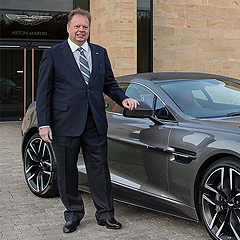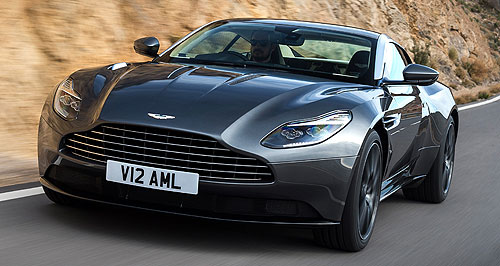Make / Model Search
News - Aston MartinAston Martin to follow Ferrari’s leadEconomics 101: Aston Martin will, like its rival Ferrari, keep production of its most desirable models – the DB11, Vantage and Vanquish super sportscar – limited to just 7000 units annually. No more than 7000 sportscars a year to keep Aston’s demand higher than supply27 Mar 2017 By TUNG NGUYEN ASTON Martin has revealed it will follow in the footsteps of its rival Ferrari and will never build enough cars for supply to meet demand, as well as keeping its special-edition vehicles exclusive enough to retain resale value and improve collectability. Speaking to GoAuto at the public debut of the Vantage S Red Bull Racing Edition in Melbourne, Aston Martin president and CEO Andy Palmer said the British supercar-maker would pursue the path laid by the Prancing Horse. “I think Ferrari, where they used to be is where we are today,” he said. “So, what Ferrari gives you is a trailblazer to say you can be very successful making 7000 sportscars a year, we make different kind of sportscars, but we’re in the same kind of space.” The space described by Mr Palmer is the super-sportscar segment, a rarefied market in which cars are often seen as a luxury statement than a method of transportation, and differentiated the two brands by their styling. “They sell beautiful but, you know, flashy, fashionable cars, where we’re looking to sell more elegant, more understated types of cars,” he said. “So different markets that don’t necessarily compete, although our mid-engined car clearly will, but I think there is room for two successful car companies in this space.” When asked if Aston could surpass Ferrari in sales, Mr Palmer said: “I don’t think it’s unreasonable to believe that we could sell a few more cars”. “In some respects, we may well pass them if you measure it from a volume point of view because we can do an SUV and they apparently are choosing not to,” he said.  Left: Aston Martin CEO Andy Palmer Left: Aston Martin CEO Andy Palmer“Let’s give Ferrari credit, what they do remarkably well is that they have a great order bank, they sell at a high price and they make a lot of money, so all I can is I aspire to be at least as good as them.” However, Mr Palmer said Aston Martin would not chase outright volume, but instead would limit supply to ensure it never outstripped demand. “We want to stay firmly rooted in luxury,” he said. “Some brands, for their own strategic reason, have decided their way forward is to sell more cars and, drawing a good example now, Porsche sell about 200,000 cars a year, Maserati is on a journey from about 40,000 aiming for about 60,000 cars a year. “In our history, the most we’ve ever produced is 7200 in a year. Right now, last year we made 3700, that will uplift this year by about 30 per cent thanks to the DB11, and our position is that we don’t want to go more than 7000 sportscars a year. “That’s where we want to cap it, we want to stay in luxury. “We don’t want to migrate to volume because when you go to volume you tend to drop your prices and your pursue filling your capacity. “We want to be in a position where our residual value is strong.” Mr Palmer cited the recently released sold out DB11 as an example, a car which, according to him, is currently worth 104 per cent of its retail value on the second hand UK market. Although not an uncommon occurrence for new sportscars with long waiting lists – prices of the current-generation Mustang often rose above the recommended retail price – Aston Martin’s special-edition models also help drive the value of the brand skyward. “In addition to the seven cars over seven years, every year we’ll do a number of specials,” Mr Palmer said. “Every year we reserve two spaces to do a unique car, so two of them a year.” Since 2015, special-edition Aston Martins have included the GT12 (100 units at £250,000), Vulcan (24 units at £1.8 million), GT8 (150 units at £150,000), Zagato coupe (99 units at £500,000) Zagato Volante (99 at £550,000), DB4 GT (25 at £1.5 million) and the recently announced Valkyrie hypercar (175 at between £2-3 million) – all of which were complete sell outs. “Part of that stabilisation (undertaken in the last few years) was underpinned by the work we do here, creating the collectibles of the future,” Mr Palmer revealed. “When you look at our history, we’ve only made about 80,000 cars in total, about 95 per cent of them are still basically on the road today. Only five per cent of those cars have disappeared from our radar. “That’s important because when you look at the collectibles, Ferrari and Aston are the two major collectible brands when you go to auction and the reason is we have this rarity value.”  Read more24th of March 2017  Aston to triple sales thanks to DBX SUV and moreMid-engined sportscar from Aston Martin also planned as Ferrari and Lambo rival20th of March 2017  Market Insight: Supercar sales race heats upAnother sales record for Lamborghini, but Ferrari continues to rule supercar roost4th of June 2016  Used car shortage for Ferrari AustralasiaItalian brand asks Aussies to sell back their beloved Ferraris |
Click to shareAston Martin articlesResearch Aston Martin Motor industry news |











Facebook Twitter Instagram